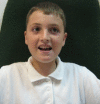ANOMALOUS HEAD POSTURES IN STRABISMUS AND NYSTAGMUS DIAGNOSIS AND MANAGEMENT
- PMID: 26978880
- PMCID: PMC5712957
ANOMALOUS HEAD POSTURES IN STRABISMUS AND NYSTAGMUS DIAGNOSIS AND MANAGEMENT
Abstract
Abnormal head positions are adopted in order to improve visual acuity, to avoid diplopia or to obtain a more comfortable binocular vision. The head can be turned or tilted toward right or left, with the chin rotated up or downwards or combination of these positions. The ophthalmologic examination including the assessment of versions leads to the diagnosis. When versions are free, the cause may be congenital nystagmus or strabismus with large angle. When versions are limited we suspect paralytic or restrictive strabismus. The head tilted to one shoulder suggests cyclotropia (IV Nerve Palsy) or congenital nystagmus. We present few of the above cases. An adequate surgical treatment can improve or correct the ocular deviation, diplopia and the abnormal head posture.
Conclusions: The abnormal head posture must be assessed and treated early in order to correct the ocular position and head posture. All patient presenting abnormal head position HAD TO BE investigated by an ophthalmologist.
Figures















References
-
- Noorden G. K, Helveston E. M. Strabismus. A decision making approach. St. Louis: Mosby; 1996. pp. 52–60.
-
- Helveston E. M. "Strabismus minute" Orbis Cybersight, Anomalous Head Posture and Strabismus. New York: 1999. Lecture 8 of 48 .
-
- Helveston E. M. "Strabismus minute" Orbis Cybersight, Surgery Options for Nystagmus. New York: 1999. Lecture 21 of 48.
Publication types
MeSH terms
LinkOut - more resources
Full Text Sources
Medical
